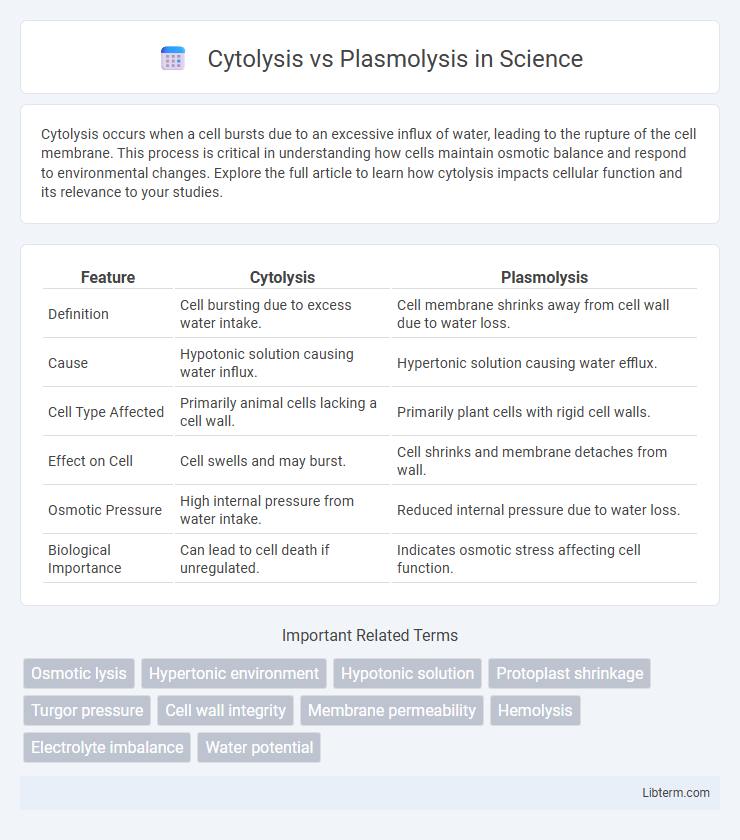Cytolysis occurs when a cell bursts due to an excessive influx of water, leading to the rupture of the cell membrane. This process is critical in understanding how cells maintain osmotic balance and respond to environmental changes. Explore the full article to learn how cytolysis impacts cellular function and its relevance to your studies.
Table of Comparison
| Feature | Cytolysis | Plasmolysis |
|---|---|---|
| Definition | Cell bursting due to excess water intake. | Cell membrane shrinks away from cell wall due to water loss. |
| Cause | Hypotonic solution causing water influx. | Hypertonic solution causing water efflux. |
| Cell Type Affected | Primarily animal cells lacking a cell wall. | Primarily plant cells with rigid cell walls. |
| Effect on Cell | Cell swells and may burst. | Cell shrinks and membrane detaches from wall. |
| Osmotic Pressure | High internal pressure from water intake. | Reduced internal pressure due to water loss. |
| Biological Importance | Can lead to cell death if unregulated. | Indicates osmotic stress affecting cell function. |
Introduction to Cytolysis and Plasmolysis
Cytolysis occurs when a cell swells and bursts due to excessive water intake in a hypotonic environment, disrupting cellular integrity. Plasmolysis involves the shrinkage of the cell membrane away from the cell wall as water exits the cell in a hypertonic solution, leading to cell dehydration and collapse. Both processes illustrate the impact of osmotic pressure on cell structure and function, critical in plant and animal cell physiology.
Definition of Cytolysis
Cytolysis is the bursting of a cell due to an influx of water when placed in a hypotonic solution, leading to membrane rupture and cell death. This process contrasts with plasmolysis, where the cell membrane detaches from the cell wall as water exits the cell in a hypertonic solution. Understanding cytolysis is crucial in cell biology for comprehending osmotic balance and cell integrity under varying environmental conditions.
Definition of Plasmolysis
Plasmolysis is the process in which plant cells lose water in a hypertonic solution, causing the cell membrane to shrink away from the cell wall. In contrast, cytolysis refers to the bursting of animal cells due to excessive water intake in a hypotonic environment. Plasmolysis highlights the effect of osmotic pressure on plant cells, leading to dehydration and structural changes distinct from cytolysis.
Causes of Cytolysis
Cytolysis occurs when a cell is placed in a hypotonic solution, causing excessive water to enter the cell, leading to swelling and eventual bursting. The increased osmotic pressure results from the imbalance between the intracellular solute concentration and the surrounding environment. Unlike plasmolysis, which is caused by water loss in hypertonic solutions, cytolysis is directly caused by osmotic influx of water into the cell.
Causes of Plasmolysis
Plasmolysis occurs when plant cells lose water due to a hypertonic environment, causing the cell membrane to shrink away from the cell wall. This process is primarily caused by exposure to high concentrations of solutes such as salt or sugar outside the cell, leading to water exiting the cell via osmosis. In contrast, cytolysis results from an excess intake of water into the cell placed in a hypotonic solution, causing the cell to swell and potentially burst.
Cellular Mechanisms Involved
Cytolysis occurs when a cell swells and bursts due to excessive water intake, typically in a hypotonic environment where water moves into the cell by osmosis, overwhelming the plasma membrane. Plasmolysis involves the contraction of the cell membrane away from the cell wall in a hypertonic solution, caused by water loss through osmosis, leading to cell shrinkage and compromised cellular functions. Both processes demonstrate critical osmotic pressure effects on cellular integrity and involve the movement of water across semi-permeable membranes mediated by osmotic gradients.
Key Differences Between Cytolysis and Plasmolysis
Cytolysis occurs when a cell swells and bursts due to excessive water intake in a hypotonic solution, while plasmolysis happens when a cell shrinks and the plasma membrane pulls away from the cell wall in a hypertonic solution. Cytolysis primarily affects animal cells lacking a rigid cell wall, whereas plasmolysis is characteristic of plant cells with a rigid cell wall. The key difference lies in water movement: cytolysis results from water rushing into the cell causing it to burst, whereas plasmolysis results from water loss causing cell membrane detachment.
Effects on Plant and Animal Cells
Cytolysis causes animal cells to burst due to osmotic imbalance when placed in a hypotonic solution, while plant cells resist bursting because of their rigid cell walls but become turgid. Plasmolysis occurs in plant cells when water exits the cell in a hypertonic solution, causing the cell membrane to detach from the cell wall and resulting in wilting; animal cells shrink instead of plasmolyzing due to lack of a cell wall. These processes highlight the importance of cell wall presence in determining cellular responses to osmotic stress in plant versus animal cells.
Real-World Examples and Applications
Cytolysis occurs when animal cells in hypotonic solutions swell and burst due to excessive water intake, as seen in freshwater protozoa like paramecia that use contractile vacuoles to prevent cell rupture. Plasmolysis is observed in plant cells exposed to hypertonic environments, such as salt-stressed crops, leading to cell membrane detachment from the cell wall and reduced turgor pressure, which impacts agricultural yield. Understanding these processes aids in developing strategies for improving crop resilience and managing osmotic stress in medical treatments like intravenous fluid administration.
Conclusion: Importance in Cell Biology
Cytolysis and plasmolysis are critical processes reflecting cell membrane integrity and osmotic balance, essential for maintaining cellular homeostasis. Understanding cytolysis helps in comprehending the consequences of hypotonic environments causing cell rupture, while plasmolysis highlights the effects of hypertonic conditions leading to cell shrinkage and metabolic disruption. These phenomena provide key insights into cell survival strategies and the development of treatments targeting osmotic stress in medical and agricultural biotechnology.
Cytolysis Infographic

 libterm.com
libterm.com